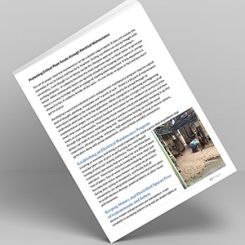Surface accoustic wave (SAW) technology offers flexibility and can lower costs.
Burkert
07/03/2017
Coriolis flow meters first came into commercial use in the 1970s, and have been developed and refined to meet a growing number of applications across a wide range of industries ever since. The demand for more advanced, non-contact measurement technology brought about the rise in ultrasonic, electro-magnetic and Coriolis technology. However, where fluid density is not required, there is now an alternative that offers increased accuracy and clean-ability.
 Image 1. Surface acoustic wave (SAW) technology can be used to deliver precision flow measurements from a smooth, uninterrupted flow-through pipe section. (Images courtesy of Burkert)
Image 1. Surface acoustic wave (SAW) technology can be used to deliver precision flow measurements from a smooth, uninterrupted flow-through pipe section. (Images courtesy of Burkert)Challenging the Constraints of Flow Measurement
Coriolis flow meters are regarded as the top specification flow meter due to their versatile capabilities for both fluids and gases. The initial cost of such devices can be high, and the design requires the flow direction to be determined before installation. Once installed there will be a pressure loss across the flow meter, depending on the specification. In addition, the designer may have to choose between drainability and accuracy. The more accurate bent-tube Coriolis flow meter can be difficult to drain and may present a contamination issue. In such cases it may be necessary to specify the straight-tube Coriolis device to ensure hygiene standards are met, but this can be at the expense of accuracy. In terms of liquid flow measurement, there is a need for a compact, non-contact device that is accurate irrespective of media characteristics, flow direction and flow conditions. In answer to that need, engineers have developed SAW technology to create a compact device that has the same hygienic properties and clean-ability as the rest of the process pipework.Simplicity Through Advanced Design
The main principle of this flow measurement device is based on the wave propagation forms similar to seismic waves, which start from an initial point of excitation and spread along the surface of a solid material. SAW technology uses at least four interdigital transducers that are located on the outside of the measuring tube and therefore have no direct contact with the fluid. Each transducer acts both as a transmitter and as a receiver. The signals that are received are processed by the on-board electronics and software, which were developed in conjunction with a university studying SAW technology and its applications. The analysis of all the signals and comparisons based on criteria such as amplitude, frequency and run times allows evaluation of the measurement, the existence of gas bubbles or solids, as well as the kind of liquid. The internal surface of the flow measurement tube can be manufactured to the same specification as the rest of the production pipeline, which means that hygienic cleaning processes, including clean-in-process (CIP) and sterilization-in-place (SIP), can be maintained to the highest standard.Accuracy Without Compromise
Until now, it has been difficult to match the accuracy levels of existing technology without introducing other weaknesses to the application. Magmeters rely on the process fluid being conductive, while other designs require components to be in direct contact with the fluid, making it difficult to meet the necessary hygiene standards. Image 2. The meter using SAW technology meets all the requirements of a hygienic application.
Image 2. The meter using SAW technology meets all the requirements of a hygienic application.Improving Technology to Reduce Costs
SAW technology offers a way to measure the flow of a liquid and its temperature without installing a large, expensive, and energy-draining piece of equipment. As well as being a leap forward in terms of size and energy use, it also enables the measuring tube to be free from parts. This cuts the risk of contaminating the medium to zero while also eliminating pressure loss, leakage and dead zones. Furthermore, SAW technology works regardless of flow direction and conductivity of the medium, and it will be developed further to measure multiple parameters. From the outset, the aims of this development project were to resolve the traditional issues associated with the Coriolis flow meter, such as clean-ability, pressure drop, weight, cost and energy consumption. At the same time, the designers were also keen to launch a product that could be improved over time, using more reference data to refine the measurement algorithms for different types of media, which is very much the case with this emerging technology.
See other Flow Meters articles here.

